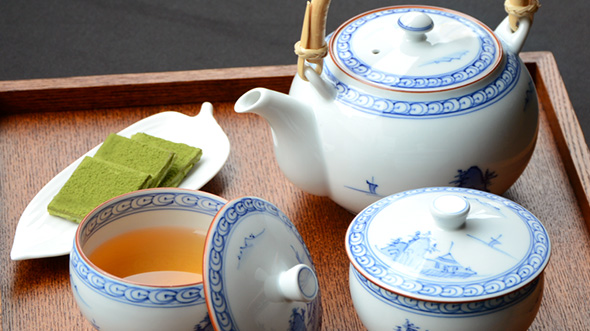

When it comes to preparing green tea, there are a variety of teapot styles you can use, from the traditional side-handled yokode kyusu to the back-handled ushirode kyusu and top-handled dobin, but what about two uniquely different Japanese teapots — the handleless shiboridashi and hōhin? If you are interested in expanding your green tea experience, keep reading for comprehensive information on shopping for, maintaining, and using a handleless Japanese teapot.
Information that is covered:
➢ Why use a teapot without a handle?
➢ Choosing Between Clay and Porcelain
➢ The Artistry of Japanese Shiboridashi and Hōhin
➢ Selecting and Serving Gyokuro
Why use a teapot without a handle?
To many, the side-handled Japanese teapot is an essential part of the tea drinking experience and a popular souvenir when traveling to Japan. The off-center handle is designed with a purpose, which is to allow the thumb to be able to secure the lid in place while pouring. So why is this ingenious design not incorporated into the shiboridashi and hōhin?
Both the shiboridashi and hōhin rightfully have earned a place in Japanese tea culture as preferred teapots for releasing the refined flavors and aromas of high-quality green tea such as gyokuro by creating the ideal brewing conditions for one serving at a time. Because the steps for brewing gyokuro are highly controlled, the temperature of the water poured into the teapot is never hot enough to be uncomfortable to the touch so a handle isn't necessary.
While these two teapots may look similar at a glance, there are several distinct characteristics that set each apart.
SHIBORIDASHI VS. HŌHIN: Understanding the Differences
| SHIBORIDASHI | HŌHIN | |
|---|---|---|
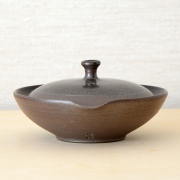 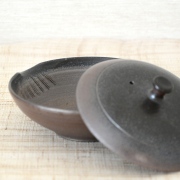 | 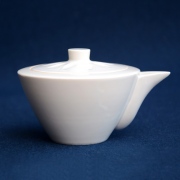 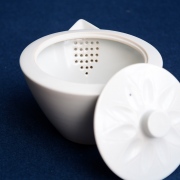 | |
| Main difference | Has no built in strainer - can be used to prepare teas with large leaves, for the lid holds the leaves back | Has built in strainer - Can be used to prepare teas with smaller leaves |
| General Size | Shallower | Deeper |
| General Shape | Resembles a bowl or plate | Resembles a cup with a straight wall |
| Brewing | Tea leaves have less room to circulate and brew | Tea leaves have more room to circulate and brew |
There is another type of Asian teapot that features similar characteristics to the shiboridashi. Originating in China, the gaiwan teapot is also ideal for brewing larger tea leaves. It may be slightly more difficult for beginners to pour with than the shiboridashi due to having a spout-less rim, but it can also be used as a teacup because of its deeper shape. Likewise, some shiboridsashi can be used in place of a gaiwan when brewing larger leafed green, white and oolong teas, such as Feng Huang Dancong teas, Wuyi oolong teas or Wen Shan Bao Zhong teas. These shiboridashi have a deeper size and a higher rim, for example Jin Hakudei Mogake Shiboridashi or Jin Tanka Hidasuki Shiboridashi.
Choosing Between Clay and Porcelain
Generally, shiboridashi and hōhin are made of clay or porcelain as these materials are the most effective in maintaining the proper temperature for gyokuro — but is one material preferred over the other?
Clay Teapots
Clay teapots are generally used by those who only drink one type of green tea. Unglazed and porous, the clay retains the flavor of the tea over time; and once used enough, it can even enhance the flavor with each following use. Another benefit of clay is it absorbs the astringency of the tea, further exposing the tea leaves' purest flavor.
Because clay will eventually begin absorbing the flavor of whatever is brewed, we recommend using only one clay teapot per type of tea in order to prevent unintended off flavors.
Porcelain Teapots
When it comes to modern teaware, porcelain teapots are quite common especially since the material does not absorb the flavor of the tea. This not only means that one teapot can be used for a variety of teas without worrying about it affecting the taste, but that the full range of the tea's subtle flavors are on full display. Porcelain is the perfect option for tea drinkers who enjoy many different kinds of green tea but would like to use just one teapot. Also, porcelain has a very good thermal conductivity, therefor hot water can heat it up really fast. Therefore, we recommend them for teas prepared with
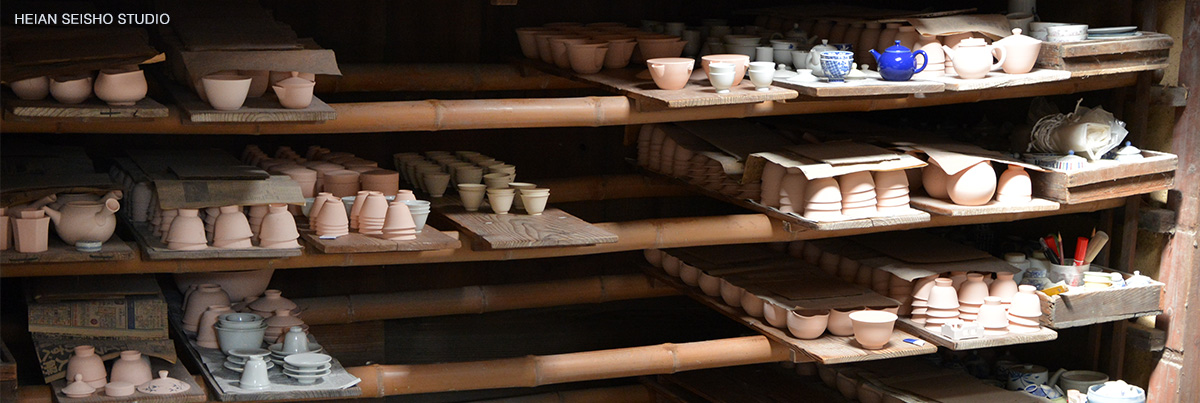
The Artistry of Japanese Shiboridashi and Hōhin
Because of the intricate detailing required for making traditional shiboridashi and hōhin teapots, only a few devoted master artisans remain in Japan. Sazen Tea is proud to offer a curated selection of handcrafted teaware by some of Japan's highly regarded craftsman.
| Artisan | Teaware | Product Name | Material | Description | |
|---|---|---|---|---|---|
 | SHIKO | Shiboridashi | Shikō - Shihō Shiboridashi Kuro | Clay | A special four-spout design that lets you easily pour into four different cups with only a few wrist movements |
 | JIN | Shiboridashi | Jin Mogake Takatsuki Shiboridashi | Clay | Elegant design with a wide, shallow base and pedestal that makes it comfortable to hold and easy to handle |
 | GYOKKO | Shiboridashi | Gyokko Shudei Sujihiki Shiboridashi | Clay | Standard shiboridashi shape that is quite practical to use |
 | SEISHO | Hōhin | Shonzui Kachomon Hōhin | Porcelain | Captivating hand-painted pattern |
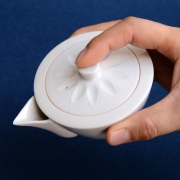 | KAWAI | Hōhin | Hakuji Hohin | Porcelain | Simple, clean, and modern design |
Advice on Proper Care and Maintenance
Both the shiboridashi and hōhin require similar care and maintenance before and after use.
◼︎ Before use:
- Rinse the inside of the teapot with lukewarm water.
- Always pour the water in the teapot slowly to avoid breaking apart the tea leaves.
◼︎ After use:
- Thoroughly wash the teapot in warm water after use. Green tea works as a natural disinfectant, so dish soap is not necessary.
- If your teapot has a built-in strainer, run water backward through the spout or use a toothpick or toothbrush to clean the strainer. Since shiboridashi have no strainers, their cleaning is very simple and easy.
- Let the teapot completely dry before storing to prevent mold growth.
◼︎ Practices to Avoid:
- Pouring very cold water immediately after very hot water into the teapot as doing so can cause cracking or chipping
- Exposing the teapot to an open flame
- Placing the teapot in a microwave or oven
- Placing the teapot in a dishwasher or washing with soap
- Scrubbing pottery decorated with colors or gold
- Using bleach to lighten discolored or stained areas
Selecting and Serving Gyokuro
High-quality gyokuro has a deep, dark green color with a glossy, damp appearance. When shopping, we suggest looking for gyokuro that has equally sized leaves with a needle-like shape. Along with shiboridashi and hōhin, we also offer many grades of high-quality gyokuro from economical premium to master grade.

Sazen Tea Recommendation: To help you find gyokuro that fits your needs, we highly recommend the following.
| Grade | Price | Product Name | |
|---|---|---|---|
 | Economical Premium | ¥1,728 / 50 g | Uji Gyokuro |
 | Premium | ¥2,808 / 40 g | Uji Premium Gyokuro TENHŌ |
 | Master Grade | ¥6,696 / 40 g | Gyokuro Chitose no Homare |
Once you have acquired a shiboridashi or hōhin and premium gyokuro, the challenge is in perfectly brewing a cup of this finnicky tea. To help you, we have created comprehensive step-by-step instructions for brewing gyokuro. By taking these diligent steps in brewing the perfect cup of tea, combined with a bit of patience, you can savor the rich umami flavor and aroma that can only be found with high-quality gyokuro tea.
Discover the Art of Tea with Shiboridashi and Hōhin
Now that you have the necessary information for selecting your ideal shiboridashi or hōhin, we invite you to browse our selection of Japanese teapots to find the perfect design for your collection. Also, if you would like to learn more about what you should consider when shopping for teaware, please read through our Essential Guide to Choosing the Perfect Japanese Tea Set.




